| Oracle® Retail Integration Bus Implementation Guide Release 13.1 |
|
 Previous |
The "customization" of an Oracle Retail Application often drives requirements to customize or extend the messages that flow among the Oracle Retail applications, or to create new message flows to support new business logic.
This section discusses the customization/extension approaches and best practices (from a RIB perspective) for extending base messages, creating new messages and adapters. These are complex topics and should be performed with great care to avoid making future generally available (GA) releases difficult or impossible to accept.
Retailers often modify retail software either in-house or through third-party system integrators. The customization and extension of Oracle Retail base products and messages are not supported by Oracle Retail, including My Oracle Support. This chapter aims to mitigate the risks of unsupported customization by providing guidance and references for how to attempt to customize safely and effectively. The tools and approaches described in this chapter are complex and require a high level of skill and knowledge of the product. Any issues that may arise with custom flows, custom APIs or customized message families are the responsibility of the customer and not Oracle Retail.
There are considerations and planning steps for customizing and extending the RIB. This planning helps to avoid having to re-install or re-architect RIB because of operational or performance problems.
The following prerequisites will help to ensure a successful customization of RIB:
A functional RIB environment without any customizations.
Familiarity with the Core RIB Concepts, components, and architecture, including an understanding of all of the following:
the Oracle database triggers, RIB adapters, RIB Message envelope, RIB Message payloads and the functionality of GETNXT () and CONSUME () stored procedures.
the integration message flow paths.
the RIB Life Cycle.
the physical and logical requirements and limitations of the RIB Components.
the RIB Operational considerations.
The tools used in the customization and extension of the RIB are separately documented. The primary tools are the Retail Functional Artifact Generator and the rib-app-builder tools. The message (payload) structure and packaging is covered in the Retail Functional Artifacts Guide.
The following documents are referenced thoroughout this chapter and are required for the customization effort:
Oracle Retail Functional Artifacts Guide
Oracle Retail Functional Artifact Generator Guide
Oracle Retail Integration Bus Operations Guide
Always keep an environment with a base version release to reproduce any base version issues. Only GA base code and messages are supported.
Always take a backup of the particular files being modified during the customization, to allow for reversal of the changes.
Always use RIB tools such as RDMT, RIHA, and the PL/SQL and javaEE api-simulators (also known as Stubby) to test the customization changes whenever possible.
Never modify the existing base flows in rib-integration-flows.xml. Modification can cause errors in functionality that are difficult to detect. Also, modifications you make to base flows do not carry over to new releases, nor are they retained when defect fixes are applied to base code and objects.
When customizing or extending the RIB messages or flows, all publishing and subscribing applications participating in the flow must be considered.
In scenarios where payload customization or the addition of a new message type for a particular message family is planned, and the flow contains a TAFR, the following rules apply:
TAFRs that do not examine RIB Message types/payloads do not require modification.
For TAFRs that examine message type/payloads for filtering or transformation purposes, the TAFR implementation code must be changed. If this code is not changed, the messsages will fail and land in RIB Error Hospital tables.
In the RIB, all messages are categorized by "message family" "message type." A message family is specific to one or more Business Objects. It defines all publishable events occuring on the Business Object(s).
The message type classifies a specific event. For example, the "Orders" message family is designed for messages regarding purchase orders, and the "Vendor" message family is associated with supplier or vendor information.
Typical message types for a message family include at least one "Create", "Mod", and "Delete" operation.
To add a new message to an existing message family, the simpliest approach is to add a new message type. The fisrt step is to determine and create the payload for the new message type. The message payload must be created following the guideline and packaging rules for RIB messages.
|
Note: See the Retail Functional Artifact Generator Guide and the Retail Functional Artifacts Guide. |
Once the desired payload is ready, follow the appropriate steps for the type of applications in the message familily and the message flow.
The new message type created for an already existing or new message family must be added in the rib-<app>-plsql-api.xml of the subscribing PL/SQL retail application.
|
Note: No configuration changes are needed in rib-<plsql app> whenever PL/SQL applications publish a new message type to which no PL/SQL applications subscribe. |
The following illustration indicates the files that must be changed inside the RIB infrastructure during the addition of a new message type when a PL/SQL application is involved in the message flow.
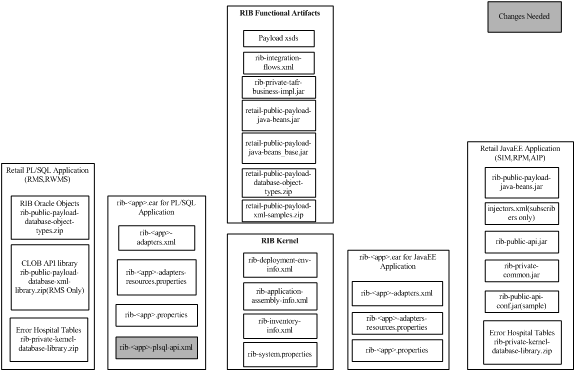
Add the new message type in rib-<app>-plsql-api.xml where app = rms or rwms, present under <RIB_HOME>/application-assembly-home/rib-<app> directory.
For example, to add a new message type, “DiffGrpFooCre,” for the“DiffGrp” message family using DiffGrpFooDesc as the payload XML that is subscribed by RWMS app: Add the message type under the <adaptorClassDef name="DiffGrp_sub"> of rib-rwms-plsql-api.xml present under <RIB_HOME>/application-assembly-home/rib-rwms as below.
> cd <RIB_HOME>/application-assembly-home/rib-rwms
> vi rib-rwms-plsql-api.xml
<adaptorClassDef name="DiffGrp_sub">
class>com.retek.rib.collab.general.OracleObjectSubscriberComponentImpl</class>
<messageFamily name="DiffGrp">
<storedProc>
<signature>{call RDMSUB_DIFFGRP.CONSUME(?,?,?,?,?)}</signature>
<useFacilityType>true</useFacilityType>
</storedProc>
<messageType name="DIFFGRPDEL">
<oracleObject>RIB_DiffGrpRef_REC</oracleObject>
</messageType>
<messageType name="DIFFGRPDTLCRE">
<oracleObject>RIB_DiffGrpDtlDesc_REC</oracleObject>
</messageType>
<messageType name="DIFFGRPDTLDEL">
<oracleObject>RIB_DiffGrpDtlRef_REC</oracleObject>
</messageType>
<messageType name="DIFFGRPHDRCRE">
<oracleObject>RIB_DiffGrpHdrDesc_REC</oracleObject>
</messageType>
<messageType name="DIFFGRPDTLMOD">
<oracleObject>RIB_DiffGrpDtlDesc_REC</oracleObject>
</messageType>
<messageType name="DIFFGRPHDRMOD">
<oracleObject>RIB_DiffGrpHdrDesc_REC</oracleObject>
</messageType>
</messageType name="DIFFGRPFOOCRE">
<oracleObject>RIB_DiffGrpFooDesc_REC</oracleObject>
</messageType>
</messageFamily>
</adaptorClassDef>
Go to the customization-workarea directory and create a file called cusom-payload.properties.
> cd <RIB_HOME>/tools-home/customization-workarea > vi custom-payload.properties
Edit the custom -payload.properties created in the step above. The custom-payload.properties would contain the new payload message definitions. The format of the definition is:
"RIBFAMILY.TYPE=IMPLEMENTATION CLASS NAME"
> vi custom-payload.properties (make changes)
For example, when adding the new message type,"DiffFooCre," under the Diffs message family, the custom-payload.properties file is modified as follows:
DIFFGRP.DIFFGRPFOOCRE=com.oracle.retail.integration.custom.bo.diffgrphdrdesc.v1.DiffGrpHdrDesc
For this example, DiffGrpFooCre calls the implementation class, DiffGrpHdrDesc.
|
Note: If there is a TAFR involved in the flow, the appropriate changes must be made to the TAFR to handle the new message types. |
Create a jar called custom-retail-public-payload-java-beans.jar in the customization-workarea directory and add the custom-payload.properties to the jar
> jar -cvf custom-retail-public-payload-java-beans.jar custom-payload.properties
Copy the newly generated custom-retail-public-payload-java-beans.jar to <RIB_HOME>/application-assembly-home/rib-func-artifacts/ directory.
Go to <RIB_HOME>/ application-assembly-home/conf and edit the rib-application-assembly-info.xml.
.vi rib-application-assembly-info.xml
Add the following line, as shown in the code example below.
<include name="lib/custom-retail-public-payload-java-beans.jar"/>
Add the following line, as shown in the code example below:
<include name="lib/custom-retail-public-payload-java-beans.jar"/>
Example:
<rib-app id="rib-tafr" type="javaee-app">
<ear>
<classpath>
<classpath refid="rib-app.global.ejb-jar.classpath"/>
<fileset dir=".">
<include name="lib/rib-private-tafr-business-impl.jar"/>
<include name="lib/rib-custom-tafr-business-impl.jar"/>
<include name="lib/custom-retail-public-payload-java-beans.jar"/>
<include name="lib/retail-public-payload-java-beans.jar"/>
</fileset>
</classpath>
<java-ee-module>
<web-war/>
<ejb-jar>
<classpath>
<classpath refid="rib-app.global.ejb-jar.classpath"/>
<fileset dir=".">
<include name="lib/rib-private-tafr-business-impl.jar"/>
<include name="lib/rib-custom-tafr-business-impl.jar"/>
<include name="lib/custom-retail-public-payload-java-beans.jar"/>
<include name="lib/retail-public-payload-java-beans.jar"/>
</fileset>
</classpath>
</ejb-jar>
<jms-jca-connector>
<classpath refid="rib-app.global.jms-jca-connector.classpath"/>
</jms-jca-connector>
</java-ee-module>
</ear>
<resource>
<resource-path refid="rib-app.global.resource-path"/>
<resource-path>
<fileset dir=".">
<include name="rib-tafr.properties"/>
<include name="rib-tafr-adapters.xml"/>
<include name="rib-tafr-adapters-resources.properties"/>
</fileset>
</resource-path>
</resource>
</rib-app>
Run the rib-app-builder compiler: Run the rib-app-compiler.sh script from <RIB_HOME>/application-assembly-home/bin directory to generate/assemble a rib-<app> and make it ready for deployment.
> cd <RIB_HOME>/application-assembly-home/bin
> sh rib-app-compiler.sh
Run the rib-app-builder deployer: Run the rib-app-deployer.sh script from <RIB_HOME>/deployment-home/bin directory as follows:
> cd <RIB_HOME>/deployment-home/bin
> sh rib-app-deployer.sh -deploy-rib-app-ear rib-<app>
The rib-<app> is deployed. Repeat this step for each rib-<app> in scope for this integration environment.
|
Note: The <app> must be an RMS or RWMS application. |
The illustration below indicates the files that must be changed inside the RIB infrastructure during the addition of a new message type when a JavaEE application is involved in the message flow.

|
Note: Creating a temporary working directory, "customization-workarea," under <RIB_HOME>/tools-home is recommendied. This directory can be used when performing customization related tasks. |
Go to the customization-workarea directory and create a file called cusom-payload.properties.
> cd <RIB_HOME>/tools-home/customization-workarea > vi custom-payload.properties
Edit the custom -payload.properties created in the step above. The custom-payload.properties would contain the new payload message definitions. The format of the definition is:
"RIBFAMILY.TYPE=IMPLEMENTATION CLASS NAME"
> vi custom-payload.properties (make changes)
For example, when adding the new message type,"DiffFooCre," under the merchier message family to call the implementation class, the custom-payload.properties file is modified as follows:
MERCHHIER.FOODEPTCRE=com.oracle.retail.integration.custom.bo.mrchhrclsdesc.v1.MrchHrDeptDesc
|
Note: See the RibMessages.xsd bundled inside rib-func-artifact.war for the maximum supported length of the message type. |
Create a jar called custom-retail-public-payload-java-beans.jar in the customization-workarea directory and add the custom-payload.properties to the jar.
jar -cvf custom-retail-public-payload-java-beans.jar custom-payload.properties
Copy the newly generated custom-retail-public-payload-java-beans.jar to <RIB_HOME>/application-assembly-home/rib-func-artifacts/ directory.
Go to <RIB_HOME>/ application-assembly-home/conf and edit the rib-application-assembly-info.xml.
> vi rib-application-assembly-info.xml
Add the following line, as shown in the code example below:
<include name="lib/custom-retail-public-payload-java-beans.jar"/>
Add the following line, as shown in the code example below:
<include name="lib/custom-retail-public-payload-java-beans.jar"/>
Example:
<rib-app id="rib-tafr" type="javaee-app">
<ear>
<classpath>
<classpath refid="rib-app.global.ejb-jar.classpath"/>
<fileset dir=".">
<include name="lib/rib-private-tafr-business-impl.jar"/>
<include name="lib/rib-custom-tafr-business-impl.jar"/>
<include name="lib/custom-retail-public-payload-java-beans.jar"/>
<include name="lib/retail-public-payload-java-beans.jar"/>
</fileset>
</classpath>
<java-ee-module>
<web-war/>
<ejb-jar>
<classpath>
<classpath refid="rib-app.global.ejb-jar.classpath"/>
<fileset dir=".">
<include name="lib/rib-private-tafr-business-impl.jar"/>
<include name="lib/rib-custom-tafr-business-impl.jar"/>
<include name="lib/custom-retail-public-payload-java-beans.jar"/>
<include name="lib/retail-public-payload-java-beans.jar"/>
</fileset>
</classpath>
</ejb-jar>
<jms-jca-connector>
<classpath refid="rib-app.global.jms-jca-connector.classpath"/>
</jms-jca-connector>
</java-ee-module>
</ear>
<resource>
<resource-path refid="rib-app.global.resource-path"/>
<resource-path>
<fileset dir=".">
<include name="rib-tafr.properties"/>
<include name="rib-tafr-adapters.xml"/>
<include name="rib-tafr-adapters-resources.properties"/>
</fileset>
</resource-path>
</resource>
/rib-app>
Run the rib-app-builder deployer: Run the rib-app-deployer.sh script from <RIB_HOME>/deployment-home/bin directory as follows.
> cd <RIB_HOME>/deployment-home/bin
> sh rib-app-deployer.sh -deploy-rib-func-artifact-war
This deploys the rib-func-artifact-war.
> sh rib-app-deployer.sh -deploy-rib-app-ear rib-<app>
This deploys the rib-<app>. Repeat this step for all rib-<app> that is in scope for this integration environment.
|
Note: The <app> must be a TAFR, SIM, or RPM application. |
|
Note: To verify the addition of a new message type for a message family, see the section, "Verifying the New Message Type". |
In RIB, all messages are categorized by message family and message type. One option for customizing the RIB is to create a new message family with a new publishing adapter and a new subscribing adapter.
If the new message family also corresponds to a topic, it is recommended that the customization also include the creation of a new topic for that family.
A publishing adapter cannot publish to more than one JMS topic.
A subscribing adapter cannot subscribe to more than one JMS topic.
The first custom message flow must start with 901, with each subsequent custom message flow id increasing by one from 901. For example, 901, 902, 903, and so on.
Each customized message flow id should be unique and must follow the sequence.
A new message family requires new (or custom) Oracle Retail Application side API(s). Each API should be written, installed and tested independently, and then connected to the custom message family flows.
The following illustration indicates the files that require changes during the addition of a new message family inside the RIB infrastructure.
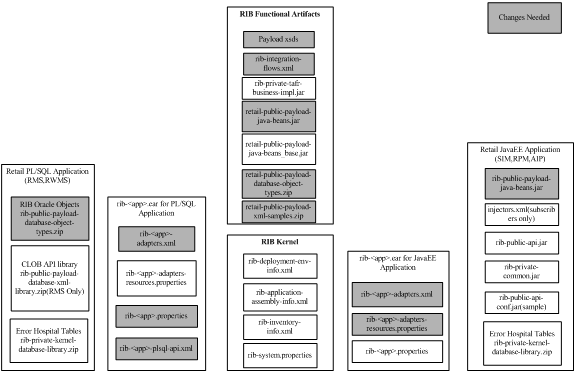
Create a temporary working directory, "customization-workarea," under <RIB_HOME>/tools-home to perform any customization related tasks.
Copy the rib-func-artifact.war present under <RIB_HOME>/application-assembly-home/rib-func-artifacts/ directory into <RIB_HOME>/tools-home/ customization-workarea/ directory.
> cd <RIB_HOME>/application-assembly-home/rib-func-artifacts
> cp rib-func-artifact.war <RIB_HOME>/tools-home/ customization-workarea
Extract the rib-integration-flows.xml from the copied rib-func-artifact.war requiring modification.
> cd <RIB_HOME>/tools-home/ customization-workarea
> jar -xvf rib-func-artifact.war integration/rib-integration-flows.xml
Define the entire flow for the particular message family in rib-integration-flows.xml present under /integration/ directory of <RIB_HOME>/tools-home/ customization-workarea.
A new custom message flow should always begin with <message-flow id="901">. Each customized message flow id should be unique and must follow the sequence. Adding a new customized message flow with a message-flow id between 1 and 900 is not recommended, as this range is reserved for adding base flows in higher versions of RIB.
For example, when adding a new message family, "Foo," that flows from the RMS application to the RWMS application, the flow is defined in rib-integration-flows.xml as follows:
<message-flow id="901">
<node id="rib-rms.Foo_pub" app-name="rib-rms"
adapter-class-def="Foo_pub" type="DbToJms">
<in-db>default</in-db>
<out-topic>etFooFromRMS</out-topic>
</node>
<node id=" rib-rwms.Foo_sub" app-name=" rib-rwms"
adapter-class-def="Foo_sub" type="JmsToDb">
<in-topic>etFooFromRMS</in-topic>
<out-db>default</out-db>
</node>
</message-flow>
The convention is as follows:
node id = rib-<app>.<family>_pub or = rib-<app>.<family>_sub or could be external-system.<family>_pub or external-system.<family>_sub
app-name = rib-<app> is the application name. The <app> is one of the following: rms, rwms, sim, rpm or tafr-- or external-system
adapter-class-def = <family>_pub or <family>_sub
type = DbToJms or JmsToDb
<in-db> means the source of the message is a database.
<out-db> means the destination of the message is a database.
<out-topic> is the topic name to which the message is published.
<in-topic> is the topic name from which the message is consumed.
Replace the previous existing rib-integration-flows.xml with the changed rib-integration-flows.xml to the /integration/ directory of rib-func-artifact.war under <RIB_HOME>/tools-home/customization-workarea/ directory and generate the rib-func-artifact.war as follows.
> cd <RIB_HOME>/tools-home/customization-workarea
> jar -uvf rib-func-artifact.war integration/rib-integration-flows.xml
Create a new publishing adapter, subscribing adapter and TAFR adapter (only if necessary), depending on the requirement for the new message family as explained later in this chapter.
Create the message family XSD.
|
Note: See the Retail Functional Artifact Guide for information about adding a new payload. |
The newly created XSD should conform to the Meta schema, IntegrationMetaschema.xsd. The artifact generator tool checks the validity of the schema before generating any artifacts. If the schema is not compliant with the IntegrationXmlMetaSchema, the artifact generator fails.
Create a new message type.
Edit the payload.properties file present in /conf directory of Rib Artifact Generator tool installation. The payload.properties contains the new payload message definitions. The format of the defination is
"RIBFAMILY.TYPE=IMPLEMENTATION CLASS NAME" > cd conf > vi payload.properties (make changes)
For example, when adding a new message type, "FooCree," (under the Foo message family) that calls the implementation class, FooDesc, the payload.properties file is modified as follows:
FOO.FOOCRE=com.oracle.retail.integration.custom.bo.foodesc.v1.FooDesc
|
Note: See the RibMessages.xsd bundled inside rib-func-artifact.war for the maximum supported length for message type. |
Run the Artifact Generator to generate functional artifacts.
> $GROOVY_HOME/bin/groovy com.oracle.retail.integration.artifact.generator.GenArtifacts.groovy -g generateBase
Upon completion of this step, the generated artifacts, the following generated artifacts are in the appropriate ./output*/dist folders: retail-public- payload-database-object-types.zip and retail-public-payload-java-beans.jar.
Copy these newly generated artifacts from the appropriate ./output*/dist folders to <RIB_HOME>/application-assembly-home/rib-func-artifacts/ directory: retail-public-payload-database-object-types.zip, retail-public-payload-java-beans.jar, and retail-public-payload-xml-samples.zip.
New entries may be needed in RIB_SETTINGS in the RMS application database to reference the new message family only if the RMS application is in scope.
Run the rib-app-builder deployer: Run the rib-app-deployer.sh script from <RIB_HOME>/deployment-home/bin directory as follows to create the new topic (etFooFromRMS) in the flow. (The prepare jms step is not destructive, so even if it is run again it would remove all the topics and recreate them.)
> cd <RIB_HOME>/deployment-home/bin > sh rib-app-deployer.sh -prepare-jms
Run the rib-app-builder compile: Run the rib-app-compiler.sh script from <RIB_HOME>/application-assembly-home/bin directory to generate/assemble a rib-<app> and make it ready for deployment.
> cd <RIB_HOME>/application-assembly-home/bin > sh rib-app-compiler.sh
Run the rib-app-builder deployer: Run the rib-app-deployer.sh script from <RIB_HOME>/deployment-home/bin directory as follows.
> cd <RIB_HOME>/deployment-home/bin > sh rib-app-deployer.sh -deploy-rib-func-artifact-war
This deploys the rib-func-artifact.war.
> sh rib-app-deployer.sh -deploy-rib-app-ear rib-<app>
The rib-<app> is deployed. Repeat this step for each Rib-<app> in scope for this integration environment.
|
Note: The <app> value must be rms, rwms, tafr, sim, or rpm. |
|
Note: To verify the addition of a new message family, see the section, "Verifying the New Message Family". |
A RIB Adapter is a component that coordinates business event (message) generation and processing with the respective Oracle Retail application interface. Each adapter in the RIB is created to handle a specific functional interface.
While adding a custom publishing, subscribing or tafr adapter it is necessary to add or modify the message flows to which you are adding a custom adapter in the rib-integration-flows.xml and update the rib-func-artifact.war and deploy the updated rib-func-artifact.war.
Example: Adding a new publisher "Foo_pub" that publishes a message for a message family "Foo" that flows from RMS to RWMS. We need to define the flow in rib-integration-flows.xml.
<message-flow id="901">
<node id="rib-rms.Foo_pub" app-name="rib-rms"
adapter-class-def="Foo_pub" type="DbToJms">
<in-db>default</in-db>
<out-topic>etFooFromRMS</out-topic>
</node>
<node id=" rib-rwms.Foo_sub" app-name=" rib-rwms"
adapter-class-def="Foo_sub" type="JmsToDb">
<in-topic>etFooFromRMS</in-topic>
<out-db>default</out-db>
</node>
</message-flow>
|
Note: Before adding the flow above to the rib-integration-flows.xml flow, it is recommended that a temporary working directory ("customization-workarea" under <RIB_HOME>/tools-home) be created. This directory can be used for performing any customization related tasks. |
Copy the rib-func-artifact.war from <RIB_HOME>/ application-assembly-home/rib-func-artifacts to <RIB_HOME>/tools-home/customization-workarea/ directory.
> cd <RIB_HOME>/ application-assembly-home/rib-func-artifacts
> cp rib-func-artifact.war <RIB_HOME>/tools-home/customization-workarea
Extract the rib-integration-flows.xml requiring modification from the copied rib-func-artifact.war as follows:
> jar -xvf rib-func-artifact.war integration/ rib-integration-flows.xml
Add the flow shown above to the rib-integration-flows.xml.
Update the rib-func-artifact.war with the modified rib-integration-flows.xml.
> jar -uvf rib-func-artifact.war integration/ rib-integration-flows.xml
Copy the rib-func-artifact.war from <RIB_HOME>/tools-home/customization-workarea to <RIB_HOME>/application-assembly-home/rib-func-artifacts/ directory.
> cd <RIB_HOME>/tools-home/customization-workarea
> cp rib-func-artifact.war <RIB_HOME>/ application-assembly-home/rib-func-artifacts
Run the rib-app-builder compiler: Run the rib-app-compiler.sh script from <RIB_HOME>/application-assembly-home/bin directory to generate/assemble a rib-<app> and make it ready for deployment.
> cd <RIB_HOME>/application-assembly-home/bin
> sh rib-app-compiler.sh
Run the rib-app-builder deployer: Run the rib-app-deployer.sh script from <RIB_HOME>/deployment-home/bin directory as follows.
"cd <RIB_HOME>/deployment-home/bin
"sh rib-app-deployer.sh -deploy-rib-func-artifact-war
The rib-func-artifact.war. is deployed.
Publishing adapters create messages from the information captured by the applications. These publishing adapters are designed to publish events for a single message family and are specific to an Oracle Retail application. This section explains how to create a new publishing adapter for a message family for a PL/SQL application (such as RMS and RWMS).
The illustration below indicates the files that require changes inside the RIB infrastructure for the addition of a new publishing adapter for a PL/SQL application.
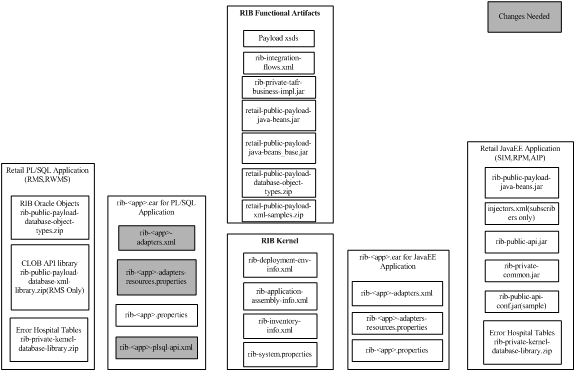
Identify the flow to which the new adapter in being added.
Define the name of the publishing adapter. It should always follow the naming convention, "RIBFAMILY_pub_ADAPTER INSTANCE NO".
Define the particular publishing adapter in rib-<app>-adapters.xml under <RIB_HOME>/application-assembly-home/rib-<app>, where <app> refers to either RMS or RWMS. The customer also must mention a custom attribute equal to "true" whenever a new customized publishing adapter is added.
For example, a new publishing adapter, "Foo_pub_1," (for the "Foo" message family) is defined in rib-<app>-adapters.xml as follows:
<timer-driven id="Foo_pub_1" initialState="running" timeDelay="10">
<timer-task>
<class name="com.retek.rib.app.getnext.impl.GetNextTimerTaskImpl"/>
<property name="maxChannelNumber" value="1" />
</timer-task>
</timer-driven>
Define the particular publishing adapter in rib-<app>-adapters-resources.properties under <RIB_HOME>/application-assembly-home/rib-<app>, where <app> refers to either RMS or RWMS.
Foo_pub_1.name=Foo Publisher, channel 1
Foo_pub_1.desc=Publisher for the Foo family through channel 1.
Define the particular publishing adapter in rib-<app>-plsql-api.xml under <RIB_HOME>/application-assembly-home/rib-<app>, where <app> refers to either RMS or RWMS, as shown in the example below.
|
Note: The signature of the stored procedure should come from the corresponding PL/SQL applications. |
<adaptorClassDef name="Foo_pub">
<class>com.retek.rib.collab.general.OracleObjectPublisherComponentImpl</class>
<messageFamily name="Foo">
<storedProc>
<signature>{call RMSMFM_FOO.GETNXT(?,?,?,?,?,?,?,?)}</signature>
<storedProc>
</messageFamily>
</adaptorClassDef>
Run the rib-app-builder compiler: Run the rib-app-compiler.sh script from <RIB_HOME>/application-assembly-home/bin directory to generate/assemble a rib-<app> and make it ready for deployment.
> cd <RIB_HOME>/application-assembly-home/bin
> sh rib-app-compiler.sh
Run the rib-app-builder deployer: Run the rib-app-deployer.sh script from <RIB_HOME>/deployment-home/bin directory as follows.
> cd <RIB_HOME>/deployment-home/bin
> sh rib-app-deployer.sh -deploy-rib-app-ear rib-<app>
The <app> is deployed.
Make the required changes to the rib-integration-flows.xml. See"Adding the Custom Adapter to the rib-integration-flows.xml File".
|
Note: To verify the addition of the new adapter, see the section, "Verifying the New Publishing Adapter". |
Publishing adapters create messages from the information captured by the applications. These publishing adapters are designed to publish events for a single message family and are specific to an Oracle Retail application. This section explains how to create a new publishing adapter for a message family for a JavaEE application, such as RPM, or SIM.
The illustration below indicates the files that require changes inside the RIB infrastructure for the addition of a new publishing adapter for a JavaEE application.
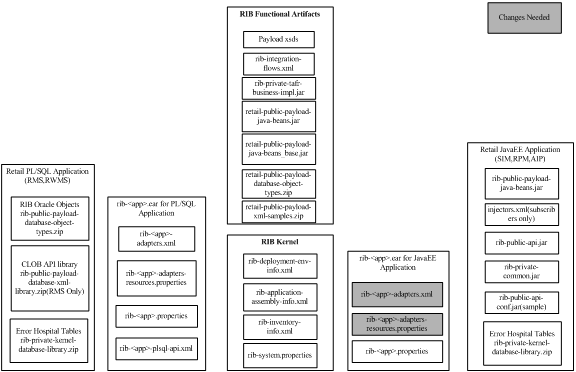
Identify the flow to which the new adapter in being added.
Define the name of the publishing adapter. It should always follow the naming convention, "RIBFAMILY_pub_ADAPTER INSTANCE NO".
Define the particular publishing adapter in rib-<app>-adapters.xml under <RIB_HOME>/application-assembly-home/rib-<app>, where <app> refers to RPM, or SIM. The customer also must mention a custom attribute equal to "true" whenever a new customized publishing adapter is added.
For example, a new publishing adapter, "Foo_pub_1," (for the "Foo" message family) is defined in rib-<app>-adapters.xml as follows:
<request-driven id=" Foo_pub_1" initialState="notConfigurable" custom="true" />
Define the particular publishing adapter in rib-<app>-adapters-resources.properties under <RIB_HOME>/application-assembly-home/rib-<app>, where <app> refers to RPM, or SIM.
Foo_pub_1.name=Foo Publisher, channel 1
Foo_pub_1.desc=Publisher for the Foo family through channel 1.
Run the rib-app-builder compiler: Run the rib-app-compiler.sh script from <RIB_HOME>/application-assembly-home/bin directory to generate/assemble a rib-<app> and make it ready for deployment.
> cd <RIB_HOME>/application-assembly-home/bin
> sh rib-app-compiler.sh
Run the rib-app-builder deployer: Run the rib-app-deployer.sh script from <RIB_HOME>/deployment-home/bin directory as follows.
> cd <RIB_HOME>/deployment-home/bin
> sh rib-app-deployer.sh -deploy-rib-app-ear rib-<app>
The <app> is deployed.
Make the required changes to the rib-integration-flows.xml. See ""Adding the Custom Adapter to the rib-integration-flows.xml File".
|
Note: To verify the addition of the new adapter, see the section, "Verifying the New Publishing Adapter". |
Subscribing adapters specific to Oracle Retail and designed to consume all messages from a specific message family.
The illustration below indicates the files that require changes inside the RIB infrastructure for the addition of a new subscriber adapter (for a particular message family) for PL/SQL applications, such as RMS or RWMS.
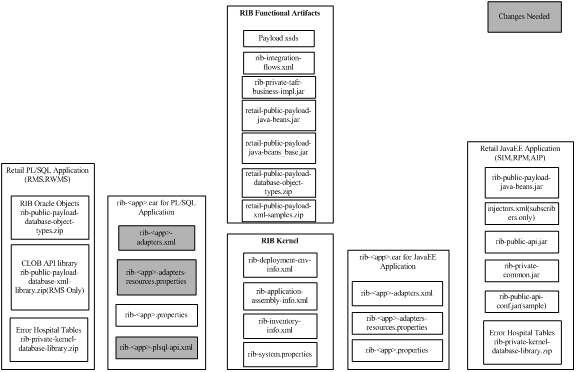
Identify the flow to which the new adapter is being added.
Define the name of the publishing adapter. It should always follow the naming convention, "RIBFAMILY_sub_ADAPTER INSTANCE NO".
Define the particular publishing adapter in rib-<app>-adapters.xml under <RIB_HOME>/application-assembly-home/rib-<app>, where <app> refers to either RMS or RWMS. The customer also must mention a custom attribute equal to "true" whenever a new customized subscribing adapter is added.
For example, a new subscribing adapter, "Foo_sub_1," (for the "Foo" message family) is defined in rib-<app>-adapters.xml as follows:
<message-driven id="Foo_sub_1" initialState="running" custom="true"/>
Define the particular subscribing adapter in rib-<app>-adapters-resources.properties under <RIB_HOME>/application-assembly-home/rib-<app>, where <app> refers to either RMS or RWMS.
Foo_sub_1.name=Foo Publisher, channel 1
Foo_sub_1.desc=Publisher for the Foo family through channel 1.
Define the particular publishing adapter in rib-<app>-plsql-api.xml under <RIB_HOME>/application-assembly-home/rib-<app>, where <app> refers to either RMS or RWMS, as shown in the example below.
|
Note: The signature of the stored procedure should come from the corresponding PL/SQL applications. |
<adaptorClassDef name="Foo_sub">
<class>com.retek.rib.collab.general.OracleObjectSubscriberComponentImpl</class>
<messageFamily name="Foo">
<storedProc>
<signature>{callRMSSUB_FOO.CONSUME(?,?,?,?)}</signature>
</storedProc>
<messageType name=" FOOCRE">
<oracleObject>RIB_FooDesc_REC</oracleObject>
</messageType>
<messageType name=" FooMOD">
<oracleObject>RIB_FooDesc_REC</oracleObject>
</messageType>
<messageType name=" FooDEL">
<oracleObject>RIB_FooRef_REC</oracleObject>
</messageType>
</messageFamily>
</adaptorClassDef>
Run the rib-app-builder compiler: Run the rib-app-compiler.sh script from <RIB_HOME>/application-assembly-home/bin directory to generate/assemble a rib-<app> and make it ready for deployment.
> cd <RIB_HOME>/application-assembly-home/bin
> sh rib-app-compiler.sh
Run the rib-app-builder deployer: Run the rib-app-deployer.sh script from <RIB_HOME>/deployment-home/bin directory as follows.
> cd <RIB_HOME>/deployment-home/bin
> sh rib-app-deployer.sh -deploy-rib-app-ear rib-<app>
The <app> is deployed.
Make the required changes to the rib-integration-flows.xml. See "Adding the Custom Adapter to the rib-integration-flows.xml File"."
|
Note: To verify the addition of the new adapter, see the section, "Verifying the New Subscribing Adapter". |
Subscribing adapters specific to Oracle Retail and designed to consume all messages from a specific message family.
The illustration below indicates the file sthat require changes inside the RIB infrastructure for the addition of a new subscriber adapter (for a particular message family) for JavaEE applications, such as SIM.
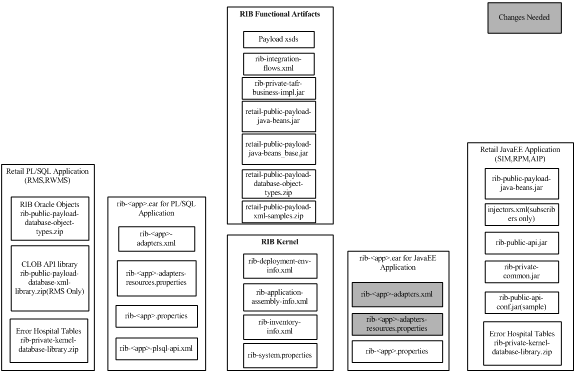
Identify the flow to which the new adapter is being added.
Define the name of the publishing adapter. It should always follow the naming convention, "RIBFAMILY_sub_ADAPTER INSTANCE NO".
Define the particular publishing adapter in rib-<app>-adapters.xml under <RIB_HOME>/application-assembly-home/rib-<app>, where <app> refers to SIM. The customer also must mention a custom attribute equal to "true" whenever a new customized subscribing adapter is added.
For example, a new subscribing adapter, "Foo_sub_1," (for the "Foo" message family) is defined in rib-<app>-adapters.xml as follows:
<message-driven id="Foo_sub_1" initialState="running" custom="true"/>
Define the particular subscribing adapter in rib-<app>-adapters-resources.properties under <RIB_HOME>/application-assembly-home/rib-<app>, where <app> refers to SIM.
Foo_sub_1.name=Foo Publisher, channel 1
Foo_sub_1.desc=Publisher for the Foo family through channel 1.
Run the rib-app-builder compiler: Run the rib-app-compiler.sh script from <RIB_HOME>/application-assembly-home/bin directory to generate/assemble a rib-<app> and make it ready for deployment.
> cd <RIB_HOME>/application-assembly-home/bin
> sh rib-app-compiler.sh
Run the rib-app-builder deployer: Run the rib-app-deployer.sh script from <RIB_HOME>/deployment-home/bin directory as follows.
> cd <RIB_HOME>/deployment-home/bin
> sh rib-app-deployer.sh -deploy-rib-app-ear rib-<app>
The <app> is deployed.
Make the required changes to the rib-integration-flows.xml. See "Adding the Custom Adapter to the rib-integration-flows.xml File".
|
Note: To verify the addition of the new adapter, see the section, "Verifying the New Subscribing Adapter". |
Transformation Address Filters/Router (TAFR) adapters transform message data and route messages. Multiple, message family specific TAFRs have already been implemented. Different TAFR adapters may be active on different message families or on the same message family depending on the needs of an application. Not all message families require TAFRs.
The following topics should be considered before writing a customized TAFR implementation for transformation, filtering or routing.
Transformation is handled in the TAFR implementation class. Here is an example method of a TAFR that handles transformation.
public RibMessage transformRibMessage(RibMessage inMsg) throws TafrException {
// Transforms the incoming RibMessage into an outgoing RibMessage
RibMessage newMsg = transform(inMsg);
return newMsg; }
Filtering configuration involves updating the rib-tafr.properties file with the appropriate information. The property follows the usual properties naming convention (name=value). The property used for filtering is:
"for.<tafr name>_tafr.drop-messages-of-types"
Example:
for.ItemsToItemsISO_tafr.drop-messages-of-types=ISCDimCre,ISCDimMod,ISCDimDel,ItemImageCre,ItemImageMod,ItemImageDel,ItemUdaDateCre,ItemUdaDateMod,ItemUdaDateDel,ItemUdaFfCre,ItemUdaFfMod,ItemUdaFfDel,ItemUdaLovCre,ItemUdaLovMod,ItemUdaLovDel
This property should be read as ,"for ItemsToItemsISO tafr" drop these message types. A comma delimits the message types. If customization is required, rib-tafr.properties files must be updated for filtering to take place.
Routing is enabled by default for TAFRs; the RIB infrastructure handles this routing. If a TAFR requires routing based on message content, implementation classes override the following method.
public void routeRibMessage(RibMessage newMsg,MessageRouterIface router) throws TafrException {
router.addMessageForTopic(eventType, newMsg);
}
This section explains how to create a new TAFR adapter for a particular message family.
The illustration below indicates the files that require changes inside the RIB infrastructure during the addition of a new TAFR adapter to a message family.
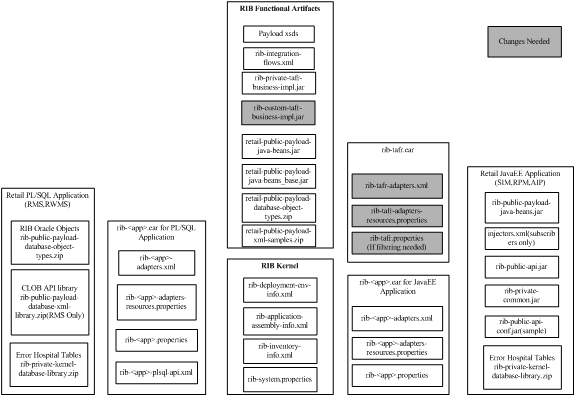
Identify the flow to which the new adapter is being added.
Define the name of the TAFR adapter. It should always follow the naming convention, "RIBFAMILY_tafr_ADAPTER INSTANCE NO".
Define the corresponding implementation class name the TAFR needs to call.
Write the implementation class for the TAFR.
The default implementation of a TAFR implements the following interface in the RIB infrastructure.
package com.retek.rib.collab.tafr;
import com.retek.rib.domain.ribmessage.bo.RibMessage;
public interface TafrIface {
@return ribMessage that has been modified from the original one
public RibMessage transformRibMessage(RibMessage ribMsgIn) throws TafrException;
/**
* Filters message or messages contents accordingly. It is possible that
* this method could filter away the entire message thus returning null
* from this method.
*
* @param ribMsg
* @return ribMessage that may have been modified from the original one
* passed in or null.
*/
public RibMessage filterRibMessage(RibMessage ribMsgIn) throws TafrException;
/**
* Routes the message to the appropriate topic for publication.
*
* @param ribMsg RibMessage to be routed to the appropriate topic.
*/
public void routeRibMessage(RibMessage ribMsgIn, MessageRouterIface
router) throws TafrException;
public void processRibMessage(RibMessage ribMsgIn, MessageRouterIface
router) throws TafrException;
}
First check if the default implementation that comes with the RIB infrastructure s is appropriate.
Create a "rib-custom-tafr-business-impl.jar" containing the customized implementation class for the specific message family and replace the same under <RIB_HOME>/application-assembly-home/rib-func-artifacts.
|
Note: See the Metalink Note, "How to Create a Custom TAFR Implementation." |
Define the particular TAFR adapter in rib-tafr-adapters.xml under <RIB_HOME>/application-assembly-home/rib-tafr. The customer must mention a custom attribute equal to "true" whenever a new customized TAFR adapter is added.
For example, when adding a new TAFR adapter, "Foo_tafr_1," for a "Foo" message family, the implementation class written is "SampleToSampleWH." It is under the package "com.retek.rib.collab.tafr.bo.impl" inside rib-custom-tafr-business-impl.jar and should be defined in rib-tafr-adapters.xml as shown below:
<message-driven id="Foo_tafr_1" initialState="running" tafr-business- impl="com.retek.rib.collab.tafr.bo.impl.SampleToSampleWH" custom="true" />
Define the particular TAFR adapter as below in rib-tafr-adapters-resources.properties under <RIB_HOME>/application-assembly-home/rib-tafr.
Foo_tafr_1.name=Foo TAFR, channel 1Foo_tafr_1.desc=TAFR for the Foo family through channel 1.
Run the rib-app-builder compiler: Run the rib-app-compiler.sh script from <RIB_HOME>/application-assembly-home/bin directory to generate/assemble a rib-<app> and make it ready for deployment.
> cd <RIB_HOME>/application-assembly-home/bin
> sh rib-app-compiler.sh
Run the rib-app-builder deployer: Run the rib-app-deployer.sh script from <RIB_HOME>/deployment-home/bin directory as follows.
> cd <RIB_HOME>/deployment-home/bin
> sh rib-app-deployer.sh -deploy-rib-app-ear rib-tafr
Make the required changes to the rib-integration-flows.xml. See "Adding the Custom Adapter to the rib-integration-flows.xml File".
|
Note: To verify the addition of the new TAFR adapter, see the section, "Verifying the New TAFR Adapter". |
If there is a need to add more functionality to an existing TAFR than what is already provided, a class can be added to extend from the original TAFR class.
Identify the TAFR to which more functionality should be added.
Define the corresponding implementation class name the TAFR needs to call. This class should extend from the original TAFR implementation class.
For example, if additional functionality is required for the ASNOutToASNIn_tafr_1 TAFR, for which the implementation class is ASNOutToASNInLocFromRibBOImpl, a new class can be written for the additional functionality that extends from ASNOutToASNInLocFromRibBOImpl. Also, if additional functionality is needed for the transformation of the message, call the transform method of the ASNOutToASNInLocFromRibBOImpl class and write the additional code/logic.
|
Note: For information on how to write the implementation class., see the Metalink Note, "How to Create a Custom TAFR Implementation." |
Write the implementation class for the TAFR.
Create a "rib-custom-tafr-business-impl.jar" containing the implementation class and replace the same under <RIB_HOME>/application-assembly-home/rib-func-artifacts.
|
Note: For more information on how to create the rib-custom-tafr-business-impl.jar, see the Metalink Note, "How to Create a Custom TAFR Implementation." |
Replace the name of the implementation class with the new class name in the rib-tafr-adapters.xml as shown below.
For example, if the name of the new class name is CustomASNOutToASNInLocFromRibBOImpl, the entry in tafr-adapters.xml should be:
<message-driven id="ASNOutToASNIn_tafr_1" initialState="running" tafr-business-impl=" com.retek.rib.collab.tafr.bo.impl.
CustomASNOutToASNInLocFromRibBOImpl " custom ="true"/>
Run the rib-app-builder compiler: Run the rib-app-compiler.sh script from <RIB_HOME>/application-assembly-home/bin directory to generate/assemble a rib-<app> and make it ready for deployment.
> cd <RIB_HOME>/application-assembly-home/bin
> sh rib-app-compiler.sh
Run the rib-app-builder deployer: Run the rib-app-deployer.sh script from <RIB_HOME>/deployment-home/bin directory as follows.
> cd <RIB_HOME>/deployment-home/bin
> sh rib-app-deployer.sh -deploy-rib-app-ear rib-tafr
This section explains how to verify the various customizations using the RIB diagnostic and test tools, RDMT, the PL/SQL API simulator, and the JavaEE API simulator.
These verification tests are described only form a RIB perspective and not as end-to-end testing. They should be considered only the first step in a process to move hte customizations thorugh the RIB life cycle.
The verificaiton steps assume that these RIB tools have already been installed and are in working condition.
To verify the addition of a new message type under a message family from a RIB perspective, complete the following steps:
Log in to the RDMT main menu.
Select menu option 3, PUB/SUB/TAFR Utilities Submenu.
Publish a message using 8 - EJB Publish Utility.
Provide the new message type when prompted for the <type> parameter.
Use the sample message that was generated using the RIB Artifact Generator tool after adding the new message type for the corresponding message family.
Check the corresponding adapter's RIBLOGS to be sure the message was published successfully. The logs are written to the path, <rib-application_instance_home>/<rib-app>/logs/<rib-app>.
For example, for /home/rib/product/10.1.3.3/OracleAS_1/j2ee/rib-rms-oc4j-instance/log/rib-rms, the RIBLOG filenames are in the format, <adapter-instance-name>.rib.log.
Example:
Alloc_pub_1.rib.log
ASNIn_sub_1.rib.log
Enable the RIB Audit Logs for all the corresponding adapters involved in the message flow. The auditing feature logs the message as it passes though the RIB infrastructure. This helps the tracing of message content from publication to subscription and all steps, such as a TAFR, in between.
Check the RIB audit logs for the particular message family adapters (publisher, subscriber, and TAFR if involved) and verify whether the new message type is part of the message header. Also ensure that the message passes successfully through all the adapters involved in the particular message flow.
Check whether the new message type was successfully consumed by the subscribing adapter. The "CONSUME" API call from the subscribing adapter should successfully return the status "S".
To verify the addition of a new message family in the RIB, complete the following steps:
Once the RIB has been compiled and deployed (after adding a new message family), check whether the new family adapters (publisher, subscriber, and TAFR if involved) are visible through RIB Admin GUI.
The RIB admin GUI can be accessed via the URL as below.
http://<server>.us.oracle.com:<http-port>/rib-<app>-admin-gui/
Replace <server> with the name or IP address of the server in the environment where the rib-<app> is deployed.
Replace <http-port> with the port number that the Oracle Application Server is listening on (for example, 7777).
Replace <app> with rms, tafr, rwms, sim, or rpm.
Log in to the RDMT main menu.
Select menu option 3, PUB/SUB/TAFR Utilities Submenu.
Publish a message using 8 - EJB Publish Utility.
Provide the new message family when prompted for the <family> parameter.
Use the sample message createdby the Functional Artifact Generator.
|
Note: See the Retail Functional Artifact Generator Guide. |
Check the corresponding adapter's RIBLOGS to be sure the message was published successfully. The logs are written to the path, <rib-application_instance_home>/<rib-app>/logs/<rib-app>.
For example, for /home/rib/product/10.1.3.3/OracleAS_1/j2ee/rib-rms-oc4j-instance/log/rib-rms, the RIBLOG filenames are in the format, <adapter-instance-name>.rib.log.
Example:
Foo_pub_1.rib.log
Foo_sub_1.rib.log
Also enable the RIB Audit Logs for all the corresponding adapters involved in the message flow. The auditing feature logs the message as it passes though the RIB infrastructure. This helps the tracing of message content from publication to subscription and all steps, such as a TAFR, in between.
Check the RIB audit logs for the particular message family adapters (publisher, subscriber, and TAFR if involved) and verify whether the new message family is part of the message header. Also ensure that the message passes successfully through all the adapters involved in the particular message flow.
To verify the addition of a new publishing adapter for PL/SQL for JavaEE applications, complete the following steps:
Once the RIB has been compiled and deployed (after adding a new publishing adapter), check whether the new publishing adapter is visible through RIB Admin GUI.
The RIB admin GUI can be accessed via the URL as below.
http://<server>.us.oracle.com:<http-port>/rib-<app>-admin-gui/
Replace <server> with the name or IP address of the server in the environment where the rib-<app> is deployed.
Replace <http-port> with the port number that the Oracle Application Server is listening on (for example, 7777).
Replace <app> with rms, rwms, sim, or rpm.
Log in to the RDMT main menu.
Select menu option 3, PUB/SUB/TAFR Utilities Submenu.
Publish a message using 8 - EJB Publish Utility.
Use the sample message createdby the Functional Artifact Generator for the corresponding message family.
Check the corresponding adapter's RIBLOGS to be sure the message was published successfully. The logs are written to the path, <rib-application_instance_home>/<rib-app>/logs/<rib-app>.
For example, for /home/rib/product/10.1.3.3/OracleAS_1/j2ee/rib-rms-oc4j-instance/log/rib-rms, the RIBLOG filenames are in the format, <adapter-instance-name>.rib.log.
Example:
Foo_pub_1.rib.log
Also enable the RIB Audit Logs for the corresponding publishing adapter involved in the message flow. The auditing feature logs the message as it passes though the RIB infrastructure. This helps the tracing of message content from publication to subscription.
Check the RIB audit logs for the particular publishing adapter and verify whether the message content is displayed correctly as published. Also ensure that the message passes successfully through all the adapters involved in the particular message flow.
To verify the addition of a new subscribing adapter for PL/SQL for JavaEE applications, complete the following steps:
Once the RIB has been compiled and deployed (after adding a new subscribing adapter), check whether the new subscribing adapter is visible through RIB Admin GUI.
The RIB admin GUI can be accessed via the URL as below.
http://<server>.us.oracle.com:<http-port>/rib-<app>-admin-gui/
Replace <server> with the name or IP address of the server in the environment where the rib-<app> is deployed.
Replace <http-port> with the port number that the Oracle Application Server is listening on (for example, 7777).
Replace <app> with rms, rwms, sim, or rpm.
Log in to the RDMT main menu.
Select menu option 3, PUB/SUB/TAFR Utilities Submenu.
Publish a message using 1 - Publish Msg Utility to the topic from which the newly added subscriber has to subscribe the message.
Use the sample message .
Check the corresponding adapter's RIBLOGS to be sure the message was subscribed from the topic successfully. The logs are written to the path, <rib-application_instance_home>/<rib-app>/logs/<rib-app>.
For example, for /home/rib/product/10.1.3.3/OracleAS_1/j2ee/rib-rms-oc4j-instance/log/rib-rms, the RIBLOG filenames are in the format, <adapter-instance-name>.rib.log.
Example:
Foo_pub_1.rib.log
Also enable the RIB Audit Logs for the corresponding subscribing adapter involved in the message flow. The auditing feature logs the message as it passes though the RIB infrastructure. This helps the tracing of message content from publication to subscription.
Check the RIB audit logs for the particular message family's subscribing adapter and verify whether the message content is displayed correctly. Also ensure that the message is subscribed successfully by the subscribing adapter.
To verify the addition of a new TAFR adapter, complete the following steps:
Once the RIB has been compiled and deployed (after adding a new TAFR adapter), check whether the new TAFR adapter is visible through RIB Admin GUI.
The RIB admin GUI can be accessed via the URL as below.
http://<server>.us.oracle.com:<http-port>/rib-tafr-admin-gui/
Replace <server> with the name or IP address of the server in the environment where the rib-<app> is deployed.
Replace <http-port> with the port number that the Oracle Application Server is listening on (for example, 7777).
Log in to the RDMT main menu.
Select menu option 3, PUB/SUB/TAFR Utilities Submenu.
Publish a message using 1 - Publish Msg Utility to the topic from which the newly added TAFR has to subscribe the message.
Use the sample message generated by the RIB Artifact Generator tool for the corresponding message family.
Check the corresponding TAFR adapter's RIBLOGS to be sure the message was subscribed by the TAFR from the particular topic and again published to the next destination topic successfully. The logs are written to the path, <rib-application_instance_home>/rib-tafr/logs/rib-tafr.
For example, for /home/rib/product/10.1.3.3/OracleAS_1/j2ee/rib-tafr-oc4j-instance/log/rib-tafr, the RIBLOG filenames are in the format, <adapter-instance-name>.rib.log.
Example:
SampleToSampleWH_tafr_1.rib.log
Also enable the RIB Audit Logs for the corresponding TAFR adapter. The auditing feature logs the message as it passes though the RIB infrastructure. This helps the tracing of message content from publication to subscription.
Check the RIB audit logs for the particular message family's TAFR adapter and verify whether the message content is displayed correctly.